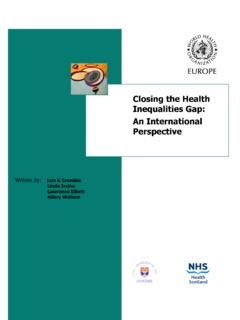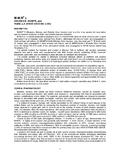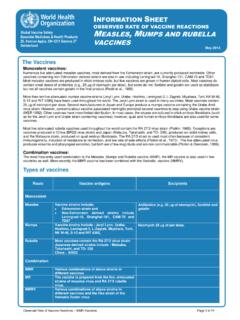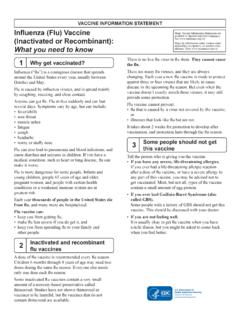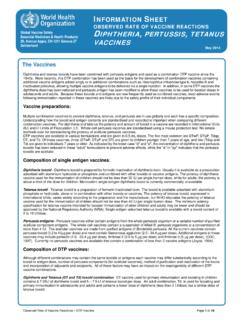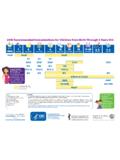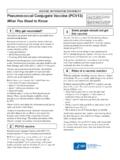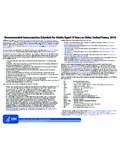Transcription of Best practice guidance // How to respond to vocal …
1 1 Best practice guidance //How to respond to vocal vaccine deniers in publicAbstractThis guidance document provides basic broad principles for a spokesperson of any health authority on how to respond to vocal vaccine deniers . The suggestions are based on psychological research on persuasion, on research in public health, communication studies and on WHO risk communication guidelines. KeywordsCOMMUNICATIONDENIAL IMMUNIZATIONINTERVIEWPUBLIC HEALTHA ddressrequests about publications of the WHO Regional Office for Europe to:PublicationsWHO Regional Office for EuropeUN City, Marmorvej 51DK-2100 Copenhagen , DenmarkAlternatively, complete an online request form for documentation, health information, or for permis-sion to quote or translate, on the Regional Office website ( ).
2 Photo credits: Front and back cover: Adobe Stock photos. World Health Organization 2017 All rights reserved. The Regional Office for Europe of the World Health Organization welcomes requests for permission to reproduce or translate its publications, in part or in designations employed and the presentation of the material in this publication do not imply the expression of any opinion whatsoever on the part of the World Health Organization concerning the legal status of any country, territory, city or area or of its authori-ties, or concerning the delimitation of its frontiers or boundaries. Dotted lines on maps represent approxi-mate border lines for which there may not yet be full mention of specific companies or of certain man-ufacturers products does not imply that they are en-dorsed or recommended by the World Health Organi-zation in preference to others of a similar nature that are not mentioned.
3 Errors and omissions excepted, the names of proprietary products are distinguished by initial capital reasonable precautions have been taken by the World Health Organization to verify the information contained in this publication. However, the published material is being distributed without warranty of any kind, either express or implied. The responsibility for the interpretation and use of the material lies with the reader. In no event shall the World Health Organization be liable for damages arising from its use. The views expressed by authors, editors, or expert groups do not necessarily represent the decisions or the stated policy of the World Health 4 Abbreviations 4 Chapter 1: Introduction What situation does this document address?
4 The term vaccine denier Who are vocal vaccine deniers ? 10 Chapter 2: The target audience Understanding the target audience 14 Chapter 3: The speaker Who should be the spokesperson? Being a good speaker Being a good listener Do s and don ts of communication 24 Chapter 4: The argument Response to vocal vaccine denier 31 Chapter 5: Unfavourable interview conditions 33 Chapter 6.
5 Embracing the opponent 34 Chapter 7: Religious beliefs How to respond to religious concerns? 38 Chapter 8: How to behave in a passionate discussion 39 Chapter 9: Participating or not 40 Chapter 10: Fake experts 42 Chapter 11: What now? 44 References 45 Annex 1: HURIER model of listening instruction 51 AcknowledgementsThis document was developed by the vaccine -preventable Diseases and Im-munization programme of the WHO Re-gional Office for Europe.
6 Lead authors were Philipp Schmid ( University of Erfurt, Germany) and Noni E. Mac-Donald (Professor, Dalhousie University, Canada).The authors would like to thankDr. Cornelia Betsch (University of Erfurt), Professor Adam Finn (Univer-sity of Bristol) and Professor Robert B hm (RWTH Aachen University) for their feedback during the development phase. The authors would also like to thank the participants of the 2016 pilot training (20 - 21 December, Copenha-gen, Denmark), the participants of the 2015 European Regional Meeting of National Immunization Programme Managers (1 3 September 2015, Ant-werp, Belgium), the participants of the 2016 technical consultation on address-ing vaccination opposition (31 May - 1 June, Belgrade, Serbia) and the mem-bers of the European Technical Adviso-ry Group of Experts on Immunization (ETAGE) for their feedback.
7 5 This guidance document provides basic, broad principles for a spokesperson of any health authority on how to behave when confronted by and how to respond to vocal vaccine deniers . vocal vaccine deniers do not accept recommended vaccines and are not open to a change of mind no matter what the scientific evidence says (see chapter for fur-ther information). The suggestions on how to respond to vocal vaccine deniers are based on psychological research on persuasion, on research in public health, communication studies and on WHO risk communication guidelines. The guidance is primarily intended for spokespersons of health authorities who want to prepare themselves for a public event with a vocal vaccine evidence indicates that no one is born a good speaker [1].
8 Training is needed to achieve this. Not everyone who is asked to speak on behalf of a health authority is a trained spokesper-son. Addressing vocal vaccine deniers in the media can be fraught with danger and angst. While the recom-mended rules of thumb outlined in this document cannot substitute for professional education in rhetoric and interview skills, they provide a practical, easy-to-use approach to improve your ability to respond to issues raised by vocal vaccine deniers . Psychological re-search has provided very useful insights on how to frame written messages in response to common misperceptions of any kind [2]. The document applies these insights to the specific situation of facing a vocal vaccine denier in a public event and focuses on designing messages to respond to vocal vaccine deniers .
9 Additionally, if the media are visual as well as auditory, the audience will judge your credibility, trustworthi-ness and competence based also on non-verbal aspects like appearance, expression of emotions, eye contact, response time, etc. [3]. This document offers strategies that address the three main elements of the process of suc-cessful communication [4][5] namely the audience, the speaker and the argument in order to maximize the positive im-pression left by you in a public discus-sion on vaccine denial. Chapter 1 Introduction6 The general public is your target audience, not the vocal vaccine denier Aim to unmask the techniques that the vocal vaccine denier is using AND correct the content Make the public audience more resilient against anti- vaccine statements and stories; support the vaccine hesitants in their vaccine acceptance decisionRule 1 Rule 2 Goal1.
10 INTRODUCTIONThe strategies presented in the follow-ing chapters convey two main rules that serve as guiding principles to rethink the way you debate and achieve the pri-mary goal of a public discussion with a vocal vaccine denier, which is to make the public resilient against anti- vaccine What situation does this document address?The recommendations and diagnos-tic processes provided here are broad principles to be used by you effectively to counter the flawed arguments of vocal vaccine deniers in a public discus-sion (Fig. 1: Situation 1). This refers to a situation in which a vocal vaccine denier is expressing arguments of science de-nialism, and your response can impact how the audience judges you, the topic, your organization and potentially health authorities as a whole.









